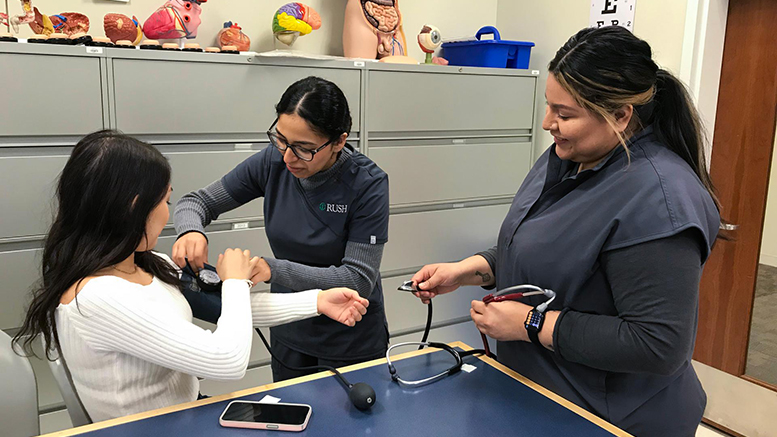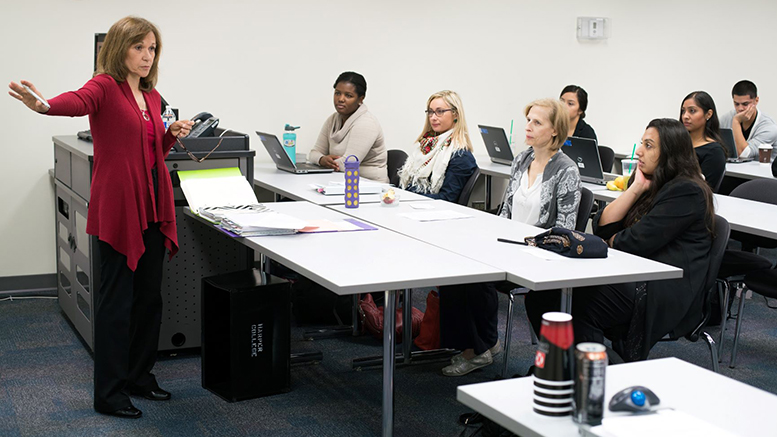
A group of Rush University Medical Center medical assistant apprentices at Harper
College.
The unique, wide-ranging apprenticeship program at Harper College in Illinois is thriving
thanks to its broad reach and rigorous expectations across the board, officials say,
and it’s paying off in several ways for the college by building seasoned relationships
in the business community.
“It really is a win-win-win in the best sense of that term,” says Michelé Smith, vice
president of workforce solutions at the college, who has seen the program grow from
having seven employers and about that many apprentices to now working with 70 employers
through 10 different programs. “It benefits all of us but also builds strong relationships
that are important to the students, the employer and to us.”
Nearly 400 students have participated in a range of career fields that have grown
to include jobs in healthcare, graphic design, insurance, banking and finance and
in more traditional sectors for apprenticeships in manufacturing and technology.
Besa Sadiku, manager of workforce initiatives for Harper, says the program was funded
initially by a five-year $2.5 million American Apprenticeship Initiative Grant from the U.S. Labor Department, but is now growing on its own.
She notes that the student experience is the focus, but the relationships with employers
pay off in several ways.
“Apprenticeships are like glue between our college and employers,” she says, noting
that the connections mean valuable experts in the field can help with college curriculum
or potentially serve as instructors, the college can be a center for research and
training for employers, and students – even those outside the apprenticeships – have
a direct link to employment opportunities with participating businesses. The employers
and their workers are also aware of other training and educational opportunities at
the college.
“They really understand what we offer, and we can learn so much from them,” Sadiku
says.
For the students
Harper now has apprenticeships in banking and finance, precision machining, mechatronics,
graphic arts, industrial maintenance, internet technology marketing and sales management,
supply chain management and health careers with five different career options.
Smith points out that students are given a great deal of support – including from
four full-time “coaches” who this year are working with about 46 apprentices expected
to graduate this spring. But the process is also rigorous, with a formal application,
interview with the employer and in-class schedule where acceptable performance is
required. The apprenticeships, all paid, vary in length from one to three years.
“We believe the academic part of this is very important,” Smith says, noting that
the student, employer and faculty member involved all must realize that they are an
equal part of the apprenticeship. She says a 36-hour work week at the job seems to
be ideal, though that can flex according to the program and employer and student needs.
“We know that apprenticeships work best when the employer allows for and prioritizes
the classroom time,” Smith says.
Sadiku said at a recent information session for about 18 prospective apprentices she
found each one had a different interest. She also notes that many of the apprentices
are incumbent workers currently employed at one of the partner companies and eager
to upgrade their skills or shift their careers.
“It is so refreshing to see so much excitement from these students who want to learn
about a field and have hands-on training. At the same time, it is great to see how
we can benefit our partners by offering pathways for their workers,” she says.
Benefiting employers
Sadiku holds those general information sessions for students and oversees the application
process, which is sometimes competitive.
For instance, a growing relationship with Rush University Medical Center, an academic
medical center in Chicago, has grown to hire about 40 apprentices since the partnership
with Harper began in fall 2022. However, 3,000 expressed interest in a recent offering
and more than 500 applied.
A sterile processing certificate can get a student trained and employed after a one-year
apprenticeship, but it also often leads to other training at Harper and other jobs
in healthcare, Smith notes.
Rush officials say it also meets the needs of their employees and prospects.
“Society is shifting toward work-life integration. Future employees want a career
that recognizes people don’t just have a home life and a work life,” says Molly Moran,
senior director of ambulatory clinical practice and workforce development for the
Rush University Medical Group. “Apprenticeships recognize that the need to go to school
in addition to working full time upsets this balance and they allow employees to earn
and learn and still have time for other aspects of their life.”
She adds that in healthcare, information changes rapidly and while apprenticeships
provide foundational coursework, they can also “upskill the apprentice based on current
patient and healthcare needs” and changing information.

A cohort of insurance apprentices in the classroom at Harper College.
Zurich North America partnered with Harper College beginning in 2016 to offer a general
insurance apprenticeship, and since that time has hired 163 apprentices and expanded
its offering to include a cybersecurity technician apprenticeship.
“In the fast-changing innovation economy of today, apprenticeship is more valuable
than ever in closing skills gaps and opportunity gaps across industries and sectors,”
said Laura Rock, chief human resources officer at Zurich, which is based in Schaumburg,
Illinois. “Apprenticeship programs attract diverse talent that can help every business
innovate and compete.”
Sadiku and Smith emphasize that the college’s approach to apprenticeships benefits
employers. The coaches communicate with the student and employer and monitor performance
and identify and work to correct any problems.
Moran says such support improves the apprenticeship.
“For community colleges who are considering building this type of program, I would
recommend looking at the structure of resources and how easily accessible they are.
For the medical assistant apprenticeship, Harper academic coaches and tutors were
always available on the cohort’s designated class day. This may seem like a small
thing, but it’s been highly impactful.”
The college also completes much of the sometimes exacting and time-consuming paperwork
for apprenticeships, screens the applicants and offers a detailed “punch list” for
the process, which rigorously tracks it, beginning with naming the apprenticeship,
setting its parameters and getting full buy-in at all levels. The interview process,
expectations and structure for monitoring performance are all clearly defined.
“We want employers to know we are very serious about our apprenticeship program and
want to build their trust,” Smith says. “At the same time, having this structure,
which all apprentices buy into, assures that they are successful.”
The college payoff
Sadiku notes that apprentices directly add to the college enrollment numbers and are
attractive to prospects considering college options. Faculty members and administrators
make important connections to the business community and get to see students move
on to the workforce. Employers often offer expertise to college programs and promote
the college in the community and among their employees.
“The apprenticeships enhance the standing the college in a number of ways,” she says.
Smith says they are central to the college’s workforce development program, which
is carefully described in a “Playbook for Business Engagement.”
“This is a key part of our strategy in really engaging the business community,” Smith
says, noting that sometimes apprenticeships are an afterthought in higher education
– and not taken seriously enough by the college or businesses. “We are very diligent
about making them work, and that means they pay off for all of us. It benefits our
employers and the college in many ways – but, most importantly, it is a wonderful
opportunity for our students to really learn about a field and the world of work and
then move on to having a leg up as they graduate and get a full-time job.”
For colleges considering apprenticeships, Moran recommends that the college and employer
have a similar goal.
“When we met with Harper to discuss the possibility of building a medical assistant apprenticeship,
it was apparent there was a common, unifying goal,” Moran says. “We both wanted to
see success for those hoping to expand their education and increase their earning
potential. When building this type of program if you don’t share that goal then nothing
else matters.”



